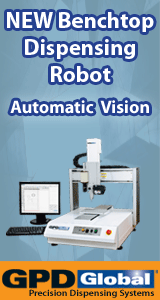First, I should state that my company manufacturers batch and inline de-fluxing systems. Because we manufacture both formats, we remain unbiased. In fact, it is in our best interest to recommend inline cleaners since they sell for considerably more than a batch system.
Russ is partially correct. Some batch cleaners are basically dishwashers with elaborate controllers. Others, however, are sophisticated, high pressure cleaning de-fluxing systems.
Specifics on batch-format de-fluxing systems vary from brand to brand but here are some highlights.
Many batch machines lack the pressure, spray diffusion pattern, and quantity of nozzles to provide effective de-fluxing. When selecting a batch machine, I would recommend a minimum spray pressure of 60 PSI. Batch machines are available with spray pressures from 10 � 110 PSI (brand and model dependent).
The type, quantity, and location of spray nozzles are also important. Nozzles that produce a fine diffusion pattern are better at under component penetration (impingement) than course (dishwasher) nozzles. Ensure that there are adequate quantities of nozzles to ensure thorough, overlapping, coverage. A four-sided spray system (nozzles located above, below and on both sides of a board rack) will reduce or eliminate shadowing.
As Russ pointed out, the removal of no-clean flux requires the use of a chemical additive. As chemicals are not free, I would recommend that you choose a cleaning system that captures, filters, and reuses its wash solution. This will reduce the volume of effluent and the cost of chemicals. Many manufacturers provide this configuration.
As many batch machines are equipped with a filtration system, most users simply direct the effluent to drain. In areas where discharge is prohibited or undesirable, an evaporator may be used to allow the cleaning system to operate in a zero-discharge configuration.
Check with the various batch cleaner manufacturers for specific configurations and details. They include:
Aqueous Technologies http://www.aqueoustech.com
EMC http://www.emcgti.com
Austin American Technology http://www.aat-corp.com
UnitDesign http://www.unitdesign.com
Cookson / Speedline http://www.speedlinetechnologies.com
I hope this helps!
Mike Konrad www.aqueoustech.com konrad@aqueoustech.com
This message was posted  the
Electronics Forum @
the
Electronics Forum @ 
reply »
![]() We have a need to clean boards. Can we use a regular dishwas...
- Oct 17, 2003
by
We have a need to clean boards. Can we use a regular dishwas...
- Oct 17, 2003
by
![]()
![]() Most batch cleaners are "dishwashers" with stainless steel p...
- Oct 17, 2003
by
RDR
Most batch cleaners are "dishwashers" with stainless steel p...
- Oct 17, 2003
by
RDR
![]()
![]()
![]() we will be using water soluble solder paste. cleaning
will ...
- Oct 17, 2003
by
we will be using water soluble solder paste. cleaning
will ...
- Oct 17, 2003
by
![]()
![]() First, I should state that my company manufacturers batch an...
- Oct 17, 2003
by
First, I should state that my company manufacturers batch an...
- Oct 17, 2003
by
![]()







